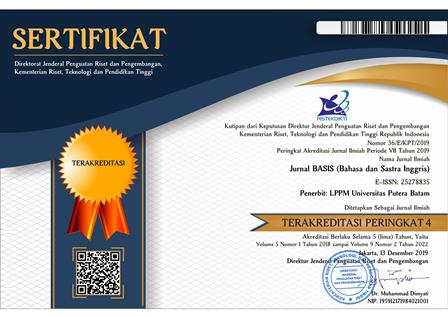THE IMPLEMENTATION OF “WRITING IN PAIRS” BASED ON STUDENTS’ PERCEPTION
DOI:
https://doi.org/10.33884/basisupb.v5i1.319Abstract
Writing skills is one of four skills that a student learns in language. Writing is a language skill with the last sequence studied by the learner. Writing in pairs is a strategy which is applied in writing. The aims of writing in pairs in learning are students and their partners can work together to get unite ideas owned by each student. This study was conducted to see how the use of writing in pairs strategy in learning writing that viewed from students perception whose results can be used as a reference for improvement in learning writing skills. The data were taken from the Essay Writing class in the English Language Education Study Program of FKIP Bung Hatta University by giving questionnaires to the students after they have studied three times of writing learning experience with writing in pairs strategy or pair work. The results showed that students were happy with the paired work strategy in writing activities. Working in pairs, learners find that it is easier to come up with an idea so that the boring writing activity is turning into a more fun activity.
References
Al-Seyabi, F. &Tuzlukova, V. (2014). Writing Problems and Strategies: An Investigative Study in the Omani School and University Context. Asian Journal of Social Sciences & Humanities, Vol 3(4): 37-48.
Attamim, Z. (2007). The Implementation of Cooperation Learning to Improve students’ Proficiency in Writing paragraph at Muhammadyah University of Ponorogo.Unpublished Thesis. Malang: Graduate Program, State University of Malang.
Linguistik, K., Sastra, D., & Silitonga, F. (2017). THE TEENEGERS’ CHARACTERISTICS IN GENDER WRITTEN TEXT BY DISCOURSE ANALYSIS AT BATAM. Kajian Linguistik Dan Sastra/ KLS, 2(1), 61–75. https://doi.org/https://doi.org/10.23917/kls.v2i1.5353
Kroll, B. (2001). Considerations for Teaching an ESL/EFL Writing Course. In Marianne Celce-Murcia. (Ed). Teaching English as a Second or ForeignLanguage (Pp. 219-232). Boston: Heinle, Chegange Learning.
Shehadeh, A. (2011). Effects and Student Perceptions of Collaborative Writing in L2.Journal of Second Language Writing,Vol 20: 286–305.
Storch, N. (1999). Are Two Heads Better Than One? Pair Work and Grammatical Accuracy. System,Vol 7:363-374.
Storch, N. (2005). Collaborative Writing: Product, Process, and Students’ Reflections.Journal of Second Language Writing, Vol 14: 153–173.
Storch, N. (2007).Investigating the Merits of Pair Work on a Text Editing Task in ESL Classes.Language Teaching Research, Vol 11 (2): 143-159.
Storch, N. (2011). Collaborative Writing in L2 Contexts: Processes, Outcomes, and Future Directions. Annual Review of Applied Linguistics. 31: 275-288.
Sabarun, (2006).Improving Writing Ability of Fifth Semester Students of EnglishDepartment of State University of Malang through Cooperative Learning Strategy.Unpublished Thesis. Malang: Graduate Program, StateUniversity of Malang.
Ulfiati, T. (2010). Cohesive Devices in Papers Written by English DepartmentStudents of State University of Malang. Unpublished Thesis. Malang: Graduate Program, State University of Malang.
Wigglesworth, G. &Storch, N. (2009). Pair versus Individual Writing: EffectsonFluency, Complexity and Accuracy. Language Testing, Vol 26(3): 445–466.
Wulyani, A. (2009). Improving Students Writing Composition through Web logging. Unpublished Thesis. Malang: PPs Malang.
54
Zakaria, A. A. O.&Mugaddam. A. R. H. (2013). An Assessment of the Written Performance of the Sudanese EFLUniversity Learners: A Communicative Approach to Writing. World Journal of EnglishLanguage, Vol 3(4): 1-10.
Downloads
Published
Issue
Section
License













 JURNAL BASIS (BAHASA DAN SASTRA INGGRIS)
JURNAL BASIS (BAHASA DAN SASTRA INGGRIS)
